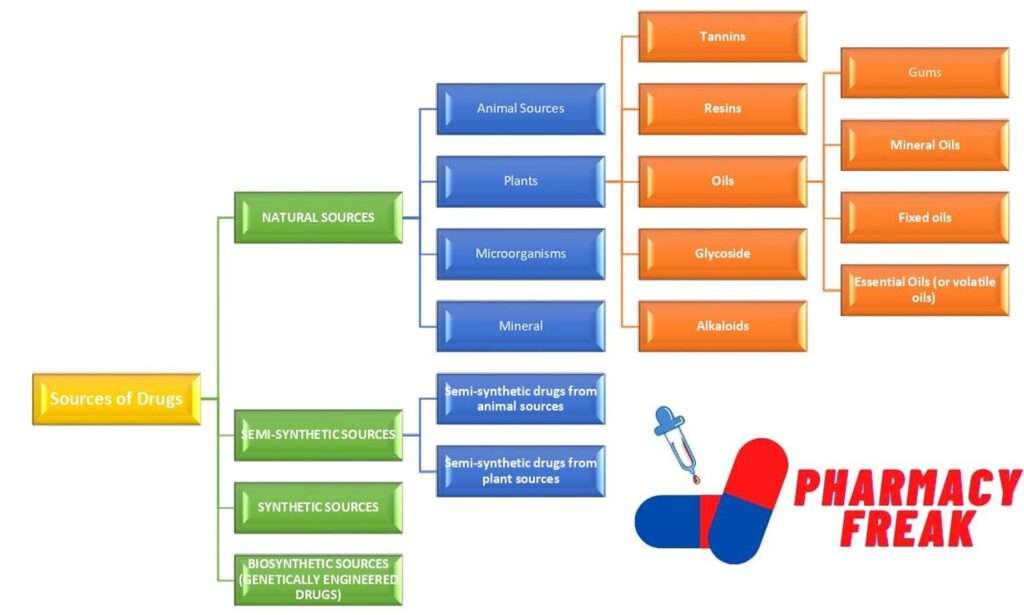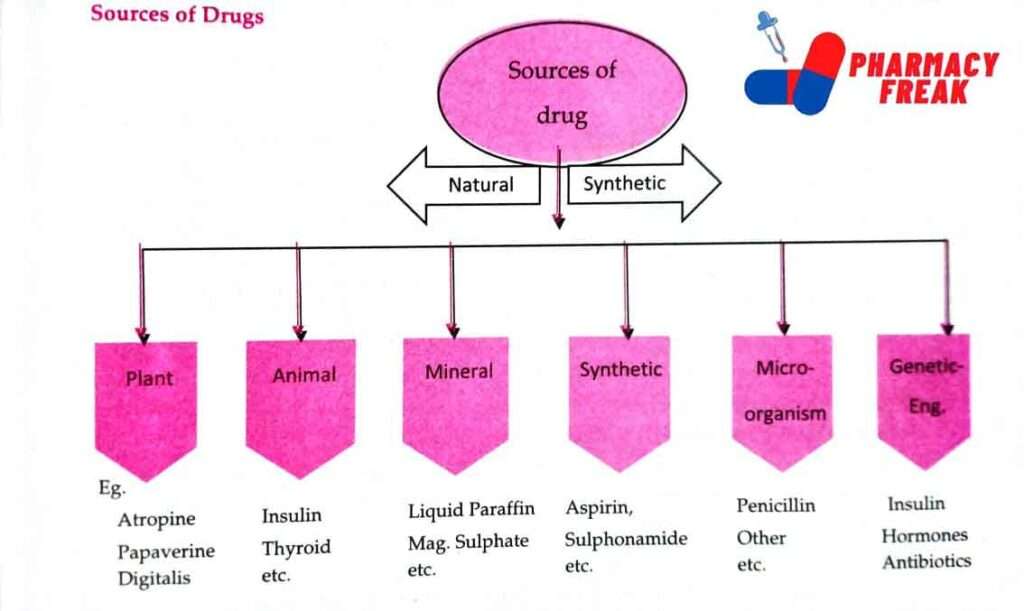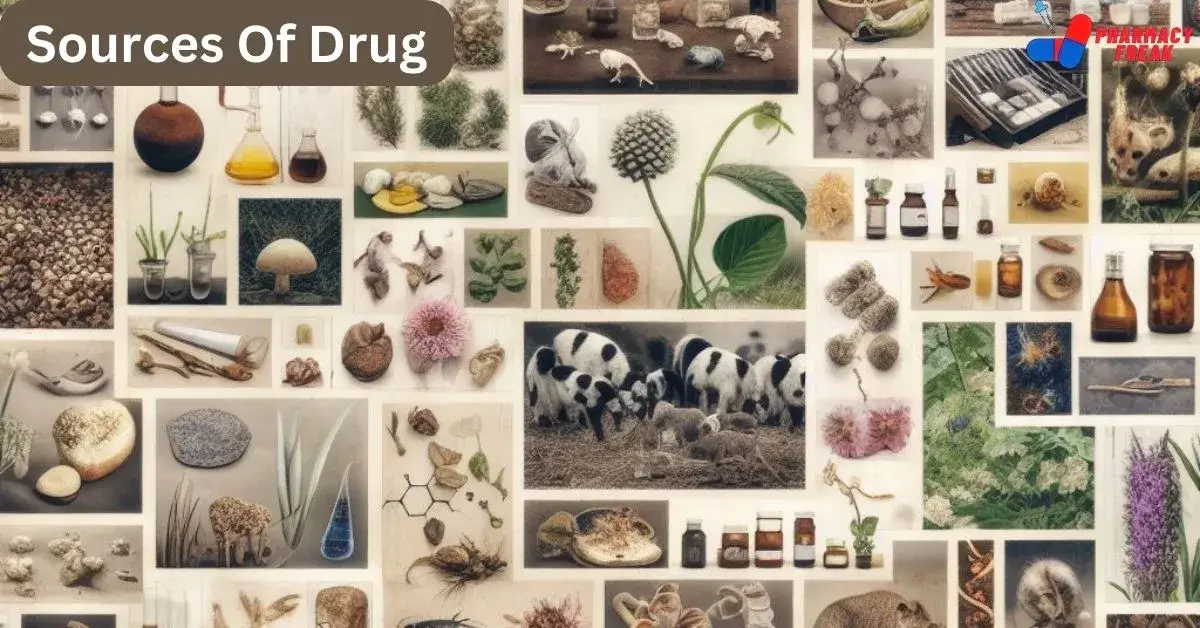Drug
A drug is any substance intended to be used for mitigation, treatment, prevention, cure, and Diagnosis of disease and disorder and for maintaining a good quality of health. Any substance that is important to impart or give therapeutic activity is known as a drug and various routes can take it up.
Table of Contents
The drug is used for the following purposes
- Diagnosis of the disease.
- Prevention of the disease.
- Treatment of disease.
- Prevention of pregnancy (i.e. contraception).
- Maintenance of optimal health.
Types of Drug
- 1. Symptomatic– Relieve disease symptoms. Aspirin, Tylenol.
- 2. Preventative– To avoid getting a disease. Hepatitis B vaccine, Flu vaccine.
- 3. Diagnostic– Help determine disease presence. Radioactive dyes.
- 4. Curative– Eliminate the disease. Antibiotics.
- 5. Health Maintenance– Help keep the body functioning normally. Insulin.
- 6. Contraceptive– Preventative
Sources of Drugs

NATURAL SOURCES
The drugs which are extracted from natural sources.
Natural sources of drugs are:
- A. Plants
- B. Animal Sources
- C. Mineral
- D. Microorganisms
Plants Sources
The following categories of drugs are derived from roots, leaves, or barks of plants
1. Alkaloids
- These are nitrogenous heterocyclic bases, which are pharmacologically active principles of plants.
- They are composed of carbon, hydrogen, nitrogen, and oxygen.
- They are bitter in taste and are often poisonous which is why they are used in small doses.
- They are insoluble in water. However, they form salts with acids that are soluble in water.
| Sr.No | Drug | Plant | Part of Plant | Use |
|---|---|---|---|---|
| 1 | Atropine | Atropa Belladdona | Leaf | Anticholinergic |
| 2 | Quinine | Chinchona | Bark | Antimalerial |
| 3 | Morphine | Opium | Dried Latex | Analgesic, Antitussive |
| 4 | Reserpine | Rauwolfia serpentia | Root | Tranquilizer |
| 5 | Strychnine | Nux-Vomica | Seed | Anticancer |
2. Glycoside
- They are an ether-like combination of a sugar moiety and with non-sugar moiety.
- They are called glycosides if the sugar moiety is glucose.
- Sugar moiety is not essential for pharmacological activity but it governs the pharmacokinetic properties of the glycoside. In the body, it may be removed to liberate aglycone.
- Pharmacological activity resides in the non-sugar moiety that is called aglycone (orgenin).
- Some examples are digitoxin, digoxin, and ouabain.
3. Oils
They are liquids that are insoluble in water. They are of three types and are used for various medicinal purposes.
a. Essential Oils (or volatile oils)
- Essential oils are obtained from leaves or flower petals by steam distillation and have an aroma.
- They have no caloric or food value.
- They do not form soaps with alkalis.
- They do not leave a greasy stain after evaporation.
- On prolonged stay, they do not become rancid (foul smell).
- They are frequently used as carminatives and astringents in mouthwashes.
- Some oils are solid at room temperature and sublime on heating e.g. menthol and camphor.
- Other examples are clove oil, peppermint oil, eucalyptus oil, and ginger oil.
b. Fixed oils
- These are glycerides of stearic, oleic, and palmitic acid.
- They are obtained from the seeds that are present within the cells as crystals or droplets.
- They are non-volatile and leave greasy stains on evaporation.
- They have caloric or food value.
- They form soaps with alkalies.
- On prolonged stay, they become rancid. They do not have marked pharmacological activity and have little pharmacological use except castor oil (purgative) or Arachis oil (demulcent). They may be of vegetable origin e.g. olive oil, castor oil, croton oil, and peanut oil, or of animal origin e.g. cod liver oil, shark liver oil, and lard.
c. Mineral Oils
- These are mostly petroleum products extracted by fractional distillation.
- These are mixtures of hydrocarbons of the methane and related aliphatic series.
- These are extracted in various consistencies – hard paraffin, soft paraffin, and liquid paraffin.
- Hard and soft paraffin are used as vehicles for the preparation of ointments while liquid paraffin is employed as a purgative.
d. Gums
- These are colloidal exudates from plants that are polysaccharides chemically and yield simple sugars on hydrolysis.
- Upon addition of water, some of them swell or dissolve or form adhesive mucilage, or remain unchanged.
Uses
- In the gut agar and psyllium seeds act as hydrophilic colloids and function as bulk purgatives.
- Gum acacia and gum tragacanth are used as suspending agents in making emulsions and mixtures.
4. Resins
These are ill-defined solid substances found in plants and are polymers of volatile oil. They are produced by oxidation and polymerization of volatile oils.
They are insoluble in water but soluble in alcohol, chloroform, and ether.
Examples: oleoresins (aspidium); gum resins (asafoetida); oleo gum resin (myrrh); balsams (benzoin, tolu, Peru); benzoin shellac, podophyllum.
Uses
- Benzoin is used as inhalation in the common cold.
- Tincture benzoin is applied as antiseptic protective sealing over bruises.
- Colophony (an oleoresin) is used as an ingredient in various plasters.
- Shellac (from Lucifer lacca) is used for the enteric coating of tablets.
- Balsams are used in the treatment of cough and bronchitis for their antiseptic and protective properties.
- Podophyllum is used as an irritant purgative.
5. Tannins
- These are non-nitrogenous phenolic plant constituents that have an astringent action.
- Pyrogallol tannins are glycosides of glucose that occur in oak galls.
- Pyrocatechol tannins are sugar-free derivatives of catechol that are present in catechu and eucalyptus.
- Tannic acid is tannin that is obtained from oak galls and is used for treating burns and diarrhea.

Animal Sources
Some animal sources continue to be used to procure some modern drugs because of cumbersome and expensive procedures for synthesizing such chemicals.
For example:
- Insulin is extracted from pork and beef pancreas and is used for the treatment of diabetes mellitus.
- Thyroid powder for treating hypothyroidism.
- Heparin is used as an anticoagulant.
- Hormones and vitamins are used as replacement therapy.
- Vaccines (cholera, T.B., smallpox, polio, and antirabies) and sera are used for (anti-diphtheria and antitetanus ) are used for prevention/treatment.
Microbiological sources

Many life-saving drugs are obtained from fungi, molds, and bacteria.
Mineral Sources
Minerals or their salts are useful pharmacotherapeutic agents.
For example:
- Ferrous sulfate is used in iron deficiency anemia.
- Magnesium sulfate is employed as a purgative.
- Magnesium trisilicate, aluminum hydroxide, and sodium bicarbonate are used as antacids for hyperacidity and peptic ulcers.
- Kaolin (aluminum silicate) is used as an adsorbent in antidiarrheal mixtures.
- Radioactive isotopes of iodine, phosphorus, and gold are employed for the diagnosis/ treatment of diseases particularly malignant conditions.
SEMI-SYNTHETIC SOURCES
Sometimes semi-synthetic processes are used to prepare drugs when the synthesis of drugs (complex molecules) may be difficult, expensive, and uneconomical or when the natural source may yield impure compounds. In these situations, this method plays an important role.
Some examples are semi-synthetic human insulin and 6-aminopenicillins acid derivatives. Prepared by chemically modifying substances that are available from a natural source to improve their potency, and efficacy and also reduce side effects.
For Example
1. Semi-synthetic drugs from plant sources
- Heroine from Morphine
- Bromoscopolamine from scopolamine
- Homatropine from atropine
2. Semi-synthetic drugs from animal sources
Animal insulin changed to be:
- Human insulin.
- 6-aminopenicillins acid derivatives.
SYNTHETIC SOURCES
At present majority of drugs used in clinical practice are prepared synthetically, such as aspirin, oral antidiabetics, antihistamines, amphetamine, chloroquine, chlorpromazine, general and local anesthetics, paracetamol, phenytoin, synthetic corticosteroids, sulphonamides, and thiazide diuretics.
Most synthetic drugs are prepared synthetically by chemical process (reaction) with the help of the knowledge of the phytochemical investigation.
Alterations are made to the naturally found structure of the drug to improve its effectiveness and to improve the finances of pharmaceutical companies.
Advantages of synthetic drugs
- They are chemically pure.
- The process of preparing them is easier and cheaper.
- Control of the quality of the drug is excellent.
- Since the pharmacological activity of a drug depends on its chemical structure and physical properties, more effective and safer drugs can be prepared by modifying the chemical structure of the prototype drug.
BIOSYNTHETIC SOURCES (GENETICALLY ENGINEERED DRUGS)
This is relatively a new field that is being developed by mixing discoveries from molecular biology, recombinant DNA technology, DNA alteration, gene splicing, immunology, and Immunopharmacology.
Some of the recent developments are genetically engineered novel vaccines (Recombinex HB hepatitis-B vaccine), recombinant DNA-engineered insulins (Humulin- human insulin) for diabetes, and interferon-alpha-2a and interferon-alpha-2b for hairy cell leukemia.
Read other articles relate to Pharmacology.
- SCOPE OF PHARMACOLOGY
- GENERAL PHARMACOLOGY
- TO study in-vitro pharmacology and physiological salt solutions.
Reference
Dr. Kiran D Patil, Dr. Pralhad K. Kanke, Dr. Md. Rageeb, Dr. Md Usman, Dr. Atul Kabra, A textbook of pharmacology-1 , pv publications. Page no 18-24.

I am a Registered Pharmacist under the Pharmacy Act, 1948, and the founder of PharmacyFreak.com. I hold a Bachelor of Pharmacy degree from Rungta College of Pharmaceutical Science and Research. With a strong academic foundation and practical knowledge, I am committed to providing accurate, easy-to-understand content to support pharmacy students and professionals. My aim is to make complex pharmaceutical concepts accessible and useful for real-world application.
Mail- Sachin@pharmacyfreak.com
